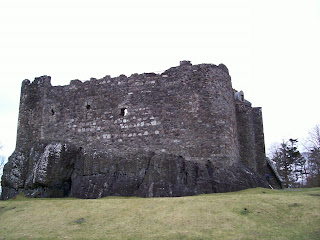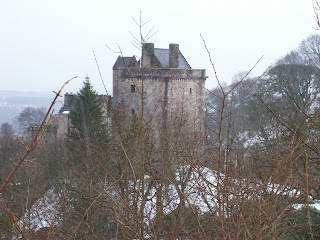Roman Army Museum and Hadrian's Wall - I liked this. It had lots of Roman Artifacts. They had a "Eagle Eye" video that showed videos of what the Wall would have looked like. I liked that movie.
Vindolanda - This had a museum to. It had some old tablets that were interesting. I also liked the recreated tower. It was neat to see what it would have looked like.
Chester's Roman Fort - This was a real fort on the wall. Daddy really like the Bath House. There was a building with lots of alters. There a a couple of free exhibits at Hadrian's wall, but we did not go to them.
Warwick Castle - It looked good from the outside! Also in Warwick is the second largest used bookstore in Great Britain. Daddy is still upset that we didn't go there.
Dunstanburg Castle - It has a long an (when it just rained) muddy trail through a golf course, but it is a fairly impressive castle. We enjoyed it.
Jedburgh Abbey - It had an audio tour that got pretty monotonous. This was the least ruined abbey that we went to, but was not our favorite.
Melrose Abbey - This abbey was my second favorite. I liked it because it looked nice, and the heart of Robert Bruce is buried there.
Dryburgh Abbey - This was my favorite abbey because it looked nice, it had an intact chapter house. It cost ten pence to go to the bathroom. There was a little tower we went up, but at the top it was ruined and the steps were about 3 inches wide!
Smailholm Tower - I liked this one very much. It had a good view of the countryside, and was just like a tower in the G. A. Henty books! At the top there was a small landing on either side. I went out there with the rest of the family, and then they went back and I could not open the door! I was scared until after a few minutes Daddy came.
Stirling Castle - I enjoyed this a lot. It was interesting, and I liked the walls and gates, but it had a little too many buildings inside.
Wallace Monument - This was good, but the climb took a long time, and the displays were not very interesting, but Daddy enjoyed the statues and audio of some of the great men of Scotland on one of the levels.
Doune Castle - Doune Castle was one of my favorite castles. It had a neat keep and walls.
Falkirk Battlefield - This battlefield only has a monument and is a little park in a neighborhood. It is not remembered very much by the Scots and does not have a visitor center like Culloden and Bannockburn. Even though there are no interpretive exhibits, it was neat to see where the battle happened.
Dunbarton Castle - This castle was fairly modern, but it had some good views, and I liked it also because it had so many cannons, and because it had a nice setup and good views. It was built on volcanic rock.
Glasgow Cathedral - This cathedral was very large and beautiful, but they were having weddings and services so you can not stay there very long. I did not like it very well.
Glasgow Necropolis - We went here mainly to see the monument of John Knox. It was interesting and had some good inscriptions, but we were not very interested in the other graves.
Bothwell Castle - This castle was not our favorite, but it was fairly interesting.
Argyll's Lodging - Rachel and Mommy enjoyed seeing how some of the court officials lived. There were some interesting maps, construction details, furniture, and dressed mannequins.
Old Town Jail - This jail was interesting, but we did not agree with some of the stuff that they said there. One thing it said was that the prisoners should not be made to work, and Daddy thinks that they should. Other than things like that, it was fine. I liked it fairly well.
Bannockburn - I enjoyed this battlefield and visitor center very much. It would have been better if you could go on more of the battlefield, but it was covered with people's houses. The visitor center explained the history of the battle and had colorful statues.
Castle Campbell - This was a pretty castle, every though we could not go inside it because it was closed until spring. The hike was not too hard, and it went around and over a stream (which I always like) and was a good trail.
Edinburgh Castle - All the guide books say that this castle is great, but we didn't like it very well because it was too big and there were so many people there. We enjoyed the highlander museum.
St. Andrew's Castle - This was a very good castle. It was large, and had some walls preserved. I especially like the mine and counter-mine. It was interesting that the mine was much bigger than the counter-mine, because the mine was built by the ones who were attacking, so they could take as long as they want, but the ones inside had to dig as quickly as they could to try to reach the mine before it broke through. There was a very small hole where the mines hit, because once there is a hole big enough for a man to get it, they would be killed if they tried to make it bigger. There was also a bottle dungeon.
St. Andrew's Cathedral - This cathedral was ruined, so I did not like it very well. But there was a tower called St. Rules tower which you could climb up. It had very good views from the top.
The Discovery - The Discovery was a very interesting ship. I liked it very much because I had just read the book Endurance about another expedition to the Antarctic. This ship was coming to rescue the crew members because it was built for ice. This ship was recreated to look like it did then.
Killiecrankie - The visitor center was closed, but I liked the battlefield. We hiked down a trail to a bridge that crossed the stream.
Glencoe - We did not like it because it was all about environmentalism and very little about the history. They had a computer game where you got points for picking up trash while hiking up the mountain, and there were not any trashcans in the restrooms.
Dunstaffnage Castle - I liked this castle because it was well preserved, but we did not get to spend much time there.
Glenfinnan Monument - This monument was pretty and there was nice scenery around there.
Culloden Battlefield - I liked this battlefield and visitor center very much. There was a display in the visitor's center about weapons, which I liked. There was also a recreated highlander house. I liked being able to see where the troops were.
Fort George - This fort was nice because you could see what the fort looked like, and I liked the walls, barracks and there were lots of cannons! There were several rooms set up like they were earlier.t
Urquhart Castle - This castle was very big and was right on Loch Ness. There was also a visitor's center with a good movie about the history of the castle. We liked it.
Lock Ness 2000 Exhibit - The exhibit was very well done, but Daddy said it was a little pricey.
Ruthven Barrack - This barrack did not have a visitor center, a place to pay or anything. It was free. It only had a few signs, so it did not tell you a whole lot about the barracks.
Here is Mommy's favorite picture, taken at Killiecrankie:
 One of Daddy's favorite pictures, taken at Glenfinnian Monument:
One of Daddy's favorite pictures, taken at Glenfinnian Monument:
My (Joshua's) favorite pictures (both taken at Stirling Castle)


Oh, and we can't forget the round-abouts! There were a lot of them (This is a picture of one from Stirling Castle) :

Overall, we enjoyed out trip to Scotland very much. If you plan to drive there, we highly recommend a vehicle with a GPS. It helped us find our way to everything, including the nearest petrol station. When we got back to the condo at night, Daddy would type in the first place we were going the next day so we knew how long it should take us to get there, and could plan what time to get up in the morning. The GPS even told us which exit to take on a roundabout (one of Mommy's favorite features.)



















































